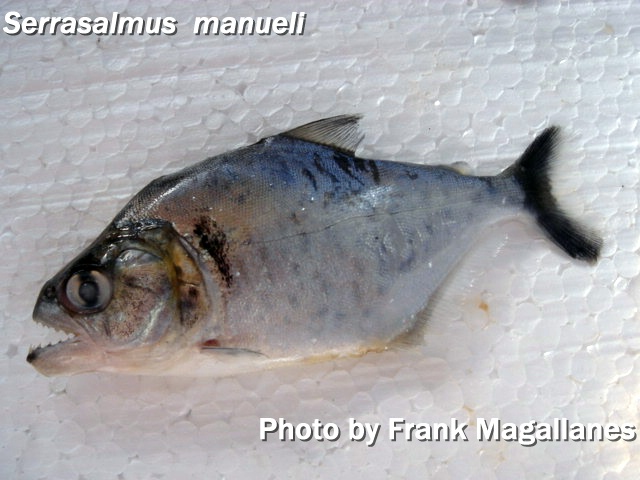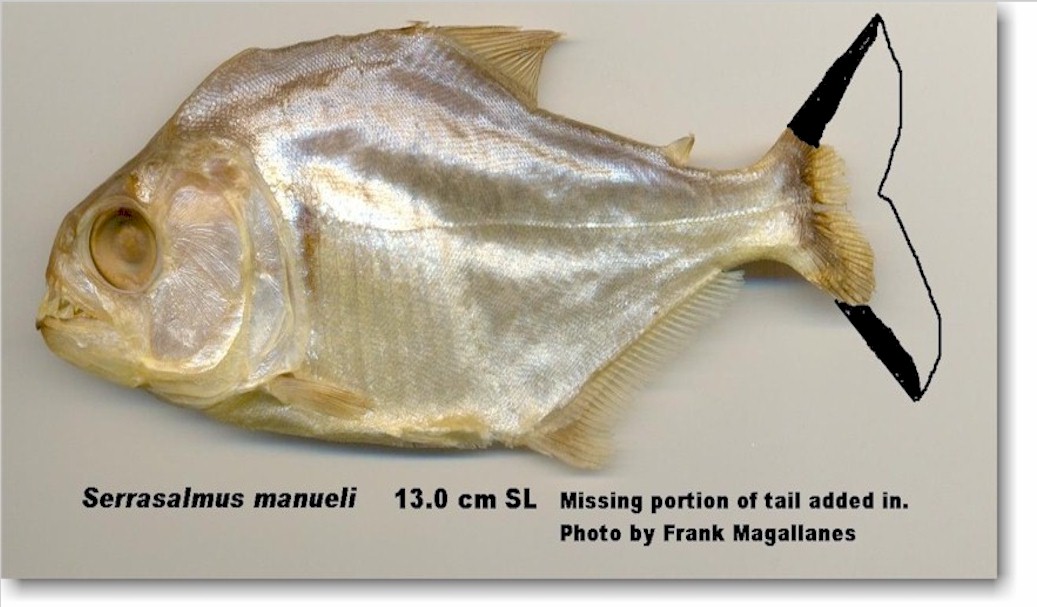CARIBITO PARGUASERO
Valid as; Serrasalmus manueli
Fernández-Yépez & Ramírez, 1967
CARIBITO PARGUASERO
Valid as; Serrasalmus manueli
Fernández-Yépez & Ramírez, 1967
*From Frank Magallanes: There appears to be contradiction between Winemiller and the fishermen on the type of water being either black or clear water. According to my research with a well known scientist from that region; it is really clear waters, but acid as they found in Aguajales or morichales, is not black water. The problem with the term white water, according to this expert, is that name is used to define water with lot of sediment load such as the Apure or Orinoco River.
Another issue coming to light is the resemblance to S. humeralis, (view) a primarily Brazilian fish found in a few other localities. It could be S. manueli might be a sister to this species. But the problem is probably deeper than that since there seem to be several fish called S. humeralis. With the recent 2010 publication of a new species S. odyssei, the name S. humeralis appears and is used for part of the material. I will be looking very carefully to find out what exactly is going on. More on this later and I will update accordingly.
The best I can offer are these photos identified as S. manueli, Venezuela and from the rio Negro and rio Xingu.
INTRODUCTION
A very sensitive to water conditions species, preferring pristine water. Which is fairly common with any piranha species. In some research quarters, they are considered as indicator species for water conditions. Much like the canary was used for mining operations. Listed as S. humeralis in some literature via photos (erroneously) from Brazil and reported to be the species bred (illegally) in captivity at a Florida amusement park. The species turned out to be Serrasalmus rhombeus (Fink, Leo Nico correspondence) a totally different species.
IN THE AQUARIUM
 Considered
by some aquarists as a delicate species in need of good water quality and
oxygenation. Recommend keeping as solitary species. This species commands high
prices in the hobby. Certainly not a fish for beginners. Expect mortality if not
properly cared for. Aquarium size would likely be in the 100 gallon minimum or
largest aquarium you can afford to buy. Frequent water changes (3x per week at
10-15%) suggested.
Considered
by some aquarists as a delicate species in need of good water quality and
oxygenation. Recommend keeping as solitary species. This species commands high
prices in the hobby. Certainly not a fish for beginners. Expect mortality if not
properly cared for. Aquarium size would likely be in the 100 gallon minimum or
largest aquarium you can afford to buy. Frequent water changes (3x per week at
10-15%) suggested.
This type of pirambeba grows huge, some exceeding 33 cm SL (Machado-Allison and Fink 1996). David (Schleser) in his Piranhas A Complete Pet Owners Manual states that "Manuel's piranha can grow to at least two feet (61 cm) in length." These fish are being captured in Venezuela and in particularly the Rio Xingu. Without a doubt a fish best left for the largest of aquariums. It has the distinctive dark "V" caudal fin and hyaline edging. This and S. gouldingi juveniles are very close in appearance. Below is the citation that pertains to this particular species and a translation to be used for educational purposes only. The large shoulder blotch is distinctive of this species. Some forms in the lower Amazon are grow larger. Usually found with S. rhombeus.
|
The map shown herein are approximate range of certain species. It does not show the complete range. |
Specimen collected by Guillermo Orti |
Rio Xingu I'm uncertain this is the correct collection point. |
Rio Xingu Juvenile I'm uncertain this is the correct collection point. |
Para State, Brazil I'm not convinced this is the correct species. |
Identified by Michel Jégu Locality: Rio Negro. |
Rio Negro |
WATER (Venezuela/Rio Cinaruco)
These are deep water fish and need good slow to medium aeration (Venezuela species). They are normally found in river channels, however they can also be found in Creeks, Lagoon, and Sand banks. The fish inhabits *black water regions (pH 4.-5.8 with low conductivity) according to Winemiller, et al. 1997. The area also undergoes a period of a dry season from October - March. The rainy season runs from April - September.
According to fishermen, as told to Edouard Paiva, in that region of the Rio Cinaruco in Venezuela you find many Serrasalmus manueli, the water is detailed here:
- The PH values goes from 4,6 to 6. The visibility is very good up to 2 meters deep and it has very few nutrients and minerals dissolved.
- The water is clear or transparent.
- It is a deep river the fishermen say that it is normally from 15 to 20 meters deep.
- The water temperature goes from 25 to 30 centigrade.
- The river has a very low current, calm water.
WATER (Brazil/rio Xingu)
Large adults are caught in very deep water in fast flowing rivers of clear water. The river has many rapids, therefore if you intend to keep S. manueli from the Brazil region, you will need a good power head and a very large aquarium for adults; (100g or more). pH 6.9-7.3, 5-12 dH, 75-82 F (24-28 C).
WILD CAUGHT
Semaprochilodus kneri, Hydrolycus armatus and other common fish species are found with S. manueli. Edouard Paiva sent pictures of a big Serrasalmus manueli captured in Rio Cinaruco in Apure State in Venezuela. It weighted 2.2 kilograms 4.84 pounds and its total length is 41 centimeters (16 inches). According to the information of the fishermen in that river it can grow a lot more than that up to 52 centimeters long and more than 3 kilograms.
Body condition and Fat stores increase significantly during this falling -water period (Jepsen et a. 1997). During the low-water season progresses, virtually all Cichla have empty stomachs, and gonadal maturation occurs in preparation for spawning just prior to the beginning of the floods (Japsen et al. 1997, Jepsen and Winemiler unpublished data). Likely, S. manueli may also fall into this category of physical changes during that period.
|
Rio Cinaruco, Venezuela |
Edouard holding large S. manueli |
Closeup of body |
S. manueli large adult, The Piranha Book (1972), pg. 17. Photo by H. R. Axelrod |
PLANTS
Eicchornia spp. Paspalum repens and other Graminaceae.
DIET
The species is known to frequent the rain forest where its diet includes seeds and fruit. It is found in the low Llanos of Venezuela (Machado-Allison and Fink, 1996 and Schleser 1997). Semaprochilodus species may be one of the foods of S. manueli, but little study has been done to confirm it. Likely, S. manueli feeds off the fins and flesh parts.
MAXIMUM SIZE
43.5 cm TL (probably grows larger).
SCIENCE
WILLIAM L. FINK: Pygocentrus manueli, Fernández-Yépez and Ramirez (1967), described as a Pygocentrus from the Rio Paraguaza of Venezuela. This species is a Serrasalmus and is discussed by Fink and A. Machado-Allison (unpubl..) and Fink and Machado-Allison (1992).
Patrón de coloración en vivo:
Los ejemplares juveniles de esta especie presentan un cuerpo de color plateado (verdoso) uniforme, con una gran mancha caudal y varias marcas o barras oscuras transversales en el cuerpo. Las aletas son incoloras y transparentes. En los adultos el cuerpo es generalmente plateado plomizo hacia las regiones dorsolateral y posterior del cuerpo. Las regions pectoral y pélvica son anaranjado a rojo fuego. Una mancha transversal alargada se dispone cubriendo tres cuartas partes de la región lateral y amarillo a anaranjado hacia las regiones ventrolateral y mandíbulas. El iris es rojo. Aletas dorsal y anal grisáceas. La anal con una mancha negra en la región disal de los primeros radios. Caudal y adiposa muy oscuras en en adultos de gran tamaño, más claras en adultos jóvenes. Mancha basal caudal en forma de "V" acostada. Aletas pectoral y pélvicas de color rojo o anaranjado tenue.
ENGLISH TRANSLATION: Pattern of live coloration:
 The
juvenile examples of this species uniformly present a body of bright silver
(greenish) color, with a large, prominent caudal blotch and various spots or
bars, which are dark and cross-sectioning the body. The fins are monochrome and
transparent. In the adult, the body generally is bright silver towards the
regions dorsolateral and back of the body. The pectoral and pelvic regions is
orange to bright red. A huge extended blotch part transverse nearly three
fourths with the lateral and yellow region to orange towards the ventrolateral
and mandible region. The iris is red. The dorsal and anal fins are grayish. The
anal with a black margin in the distal region of the first radii. The caudal and
adipose are very dark in in large adults, clearer in young adults. A prominent 'V"
forms the caudal basal spot. The pectoral and pelvic fins may be red or
reddish-orange coloration.
The
juvenile examples of this species uniformly present a body of bright silver
(greenish) color, with a large, prominent caudal blotch and various spots or
bars, which are dark and cross-sectioning the body. The fins are monochrome and
transparent. In the adult, the body generally is bright silver towards the
regions dorsolateral and back of the body. The pectoral and pelvic regions is
orange to bright red. A huge extended blotch part transverse nearly three
fourths with the lateral and yellow region to orange towards the ventrolateral
and mandible region. The iris is red. The dorsal and anal fins are grayish. The
anal with a black margin in the distal region of the first radii. The caudal and
adipose are very dark in in large adults, clearer in young adults. A prominent 'V"
forms the caudal basal spot. The pectoral and pelvic fins may be red or
reddish-orange coloration.
DISTRIBUTION
Amazon and Orinoco river basins: Brazil and Venezuela.
rio Sipapo, 3 km arriba de Pendare, Amazonas
rio Cinaruco, cerca boca del Orinoco, Apure
rio Cassiquiare, boca del Pamoni, Amazonas
rio Orinoco, rio abajo Quintare, Amazonas
rio Cunucunuma, Amazonas
rio Atabapo, Amazonas
Xingu river, Brazil
RESEARCH HELP
Antonio Machado-Allison
Edouardo Paiva
REFERENCES
Machado-Allison, A. and W. L. Fink, 1996 - Los Peces Caribes de Venezuela, Diagnosis, Claves, Aspectos Ecologicos Y Evolutivos, pg.71.
Schleser, David 1997 - Piranhas, A Complete Pet Owner's Manual, Barrons, Hauppauge, NY.
Fernández-Yépez, A. and M. V. Ramírez 1967 Los Caribes (serrasalmidos) de Venezuela y las pesquerias. Privately published. Venezuelan Serrasalmids: 1-25. [Fink 1993 cites publication as: Primer Foro internac. Planif. y Desarr. Pesquero; not found on CAS copies.]
Fink, W. L. 1993 (18 Aug.) Revision of the piranha genus Pygocentrus (Teleostei, Characiformes). Copeia 1993 (no. 3): 665-687.
Jepsen, D.B. and K.O. Winemiller. 2002 Structure of tropical river food webs revealed by stable isotope ratios. Oikos 96: 46-55.
Layman, Craig A. and Winemiller, Kirk O. 2005 Patterns of habitat segregation among large fishes in a Venezuelan floodplain river. Neotropical Ichthyology, 3(1): 103-109. Sociedada Brasileira de Ictiologia.
Jepsen, D.B. and K.O. Winemiller, and D.C. Taphorn. 1997. Temporal patterns of resource partitioning among Cichla species in a Venezuelan blackwater river. J. Fish Biol. 50: 1-24.
USE YOUR BACKSPACE TO RETURN OR CLICK HERE TO RETURN SERRASALMUS LIST
USE THIS LINK TO RETURN TO RESEARCH PAGE.
TO RETURN HOME CLICK HERE.
The OPEFE web site and its contents; is disclaimed for purposes of Zoological Nomenclature in accordance with the International Code of Zoological Nomenclature, Fourth Edition, Article 8.3 and 8.4. No new names or nomenclature changes are available from statements at this web site.
Copyright© 1994-2012 Oregon Piranha Exotic Fish Exhibit (The OPEFE fish exhibit is permanently CLOSED as of 2000) Sutherlin, Oregon. Information posted on this web site is archival data on fish scientific classifications and other information. DISCLAIMER: The copyrighted material may not be used for any purpose other than private study, scholarship or research. Cited information requires credit and this link www.opefe.com. All rights reserved. All images shown (unless otherwise noted) is property of OPEFE.
UPDATED: 12/26/2011